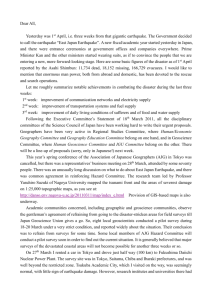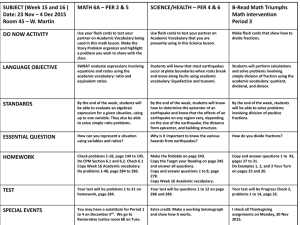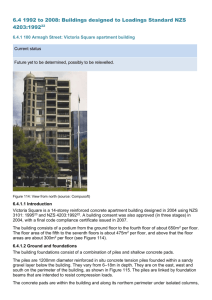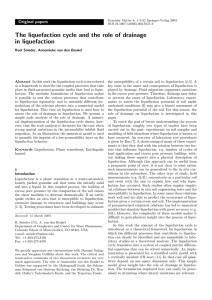Validation of the Energy Method to Predict the Liquefaction Case History Analysis
advertisement
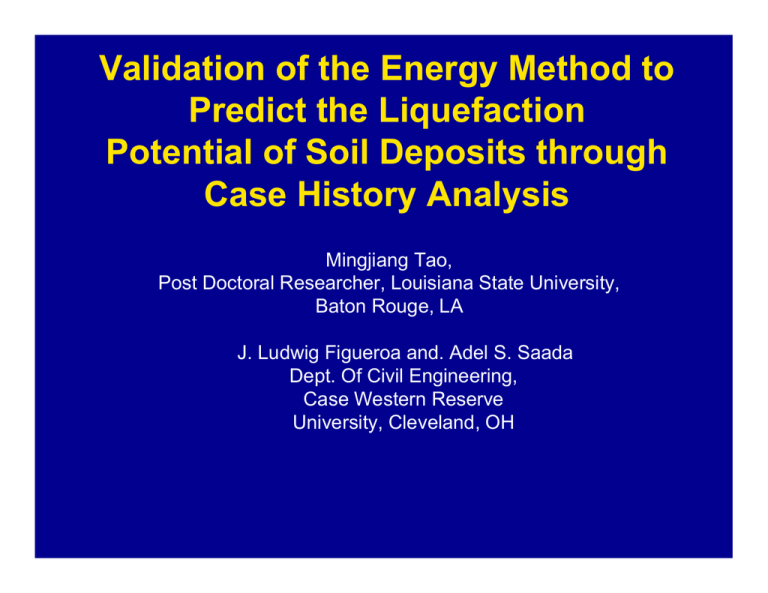
Validation of the Energy Method to Predict the Liquefaction Potential of Soil Deposits through Case History Analysis Mingjiang Tao, Post Doctoral Researcher, Louisiana State University, Baton Rouge, LA J. Ludwig Figueroa and. Adel S. Saada Dept. Of Civil Engineering, Case Western Reserve University, Cleveland, OH OUTLINE ! INTRODUCTION ! NUMERICAL INTEGRATION PROCEDURE ! CASE HISTORY VERIFICATION !Non Liquefaction Case !Liquefaction Case ! SUMMARY AND CONCLUSIONS INTRODUCTION Previous Research: 1. Liquefaction Resistance of sands was defined in terms of the Unit Energy using Torsional Shear Testing a. Found that the Unit Energy was independent of type of loading whether harmonic or random b. Developed relationships between the Unit Energy (dep. variable) and Effect. Conf. Pressure, Relative Density and Grain Size Characteristics 2. Developed a Unit energy-based one-dimensional analytical model to reconstruct in-situ soil behavior from which the induced level of energy could be determined. - Liquefaction susceptibility could be determined by comparing the induced vs. the resistant level of energy 3. Developed relationships to reconstruct the pore pressure buildup using the Unit Energy. Previous Research (cont): 4. Developed relationships to calculate degradation parameters based on the Unit Energy. They allow the reconstruction of the time history of shear strength and shear modulus 5. Conducted a validation study of the energy method using dynamic centrifuge tests. 6. Tested hollow cylinder sand with significant amount of silt specimens under torsional shear to determine their resistance to liquefaction in terms of the Unit Energy. 7. Conducted a field verification study using Case Histories A modified numerical procedure to estimate the seismic response of level ground A Modified Numerical Procedure Equations of Motion x 0 y σ zz ( t ) Ground Surface z τ yz ( t ) τ xz ( t ) ∂ 2U ( z , t ) ∂τ xz ( z , t ) − =0 ρ ( z) 2 t z ∂ ∂ ∂ 2V ( z , t ) ∂τ yz ( z , t ) − =0 ρ ( z) 2 ∂t ∂z ∂ 2W ( z , t ) ∂σ zz ( z , t ) − =0 ρ ( z) 2 ∂t ∂z (20) Boundary conditions: τ xz ( 0, t ) = 0 τ yz ( 0, t ) = 0 az(t) ax(t) ay(t) Bedrock Stress-State of a Soil Element Subjected to Earthquake Loading U ( 0, t ) = U x ( t ) V ( 0, t ) = U y ( t ) At the ground surface (21) At the bedrock (22) Hysteretic loops: generally consisting of the backbone, the unloading and reloading branches Unloading and reloading curves: Backbone curve: Hyperbolic model τ = Gmγ = f (γ Gm 1+ γ ) (23) τ −τ a c τf = Gm γ −γa c Gm γ − γ a 1+ c τf τ f τa Reloading curve c = 1− τa τ f γa Unloading curve c = −1 − τ τ a f (24) Modified degradation models for shear modulus and shear strength: δW 1 = − G G A mt m0 1 ′ σ c τ = τ 1 − A δ W f 0 1 ft ′ σ c δW = − − 1 G G A B mt m0 2 2 σ c′ τ = τ 1 − A δ W − B f0 2 2 ft σ c′ Gmt Gm 0 ≥ 0.9 (25) τ ft τ f 0 ≥ 0.9 G m t G m 0 < 0 .9 (26) τ ft τ f 0 < 0 .9 A numerical solution based on Finite Difference Method (Take X direction as an example m jU&& j ,t +∆t = τ j ,t −τ j +1,t = f γ j ,t − f γ j +1,t ( ) ( ) = F (U j −1,t ,U j ,t ,U j +1,t ) Calculate one time step from tn k 1 = ∆ tF (U n , U& n , t n k 2 = ∆ tF U k 3 = ∆ tF U k 4 = ∆ tF U U U& n +1 =U n + n +1 = U& n + U&& n + 1 = F (U to (27) tn +1 ) 1 1 1 n + ∆ tU& n , U& n + k 1 , t n + ∆ t 2 2 2 1 1 1 1 n + ∆ t U& n + k 1 , U& n + k 2 , t n + ∆ t 2 2 2 2 &n 1 &n n + ∆ t U + k 2 ,U + k3 , tn + ∆ t 2 ∆ t U& n + ( k 1 + k 2 + k 3 ) 6 k 1 + 2 ( k 2 + k 3 ) + k 4 6 n +1 , U& n + 1 , t n + 1 ) (28) Procedure summary: • Input: soil properties, degradation parameters, Initial conditions: 0 Gmj ρj τ 0fj U 0j = 0 τ Nt +1 = 0 t • At the beginning of each time step, V j U tj are known at each layer boundary; • The shear strain in the jth layer at time, γ t j can be obtained by using γ j ,t = U j ,t − U j −1,t • The unloading and reloading curves can be constructed by using Eq. (24); • Calculate the dissipated unit energy due to the EW and the NS components individually, and then add them up; • Update the shear modulus and strength at each reversal loading point; • Repeat the above steps until the duration of the earthquake is over. hj A Step-by-Step Energy-Based Procedure to Assess Liquefaction Potential of Soil Deposits Step 1) Determination of the liquefaction resistance in terms of the unit energy Step 2) Determination of the Amount of Dissipated Unit Energy into the Soil during the Expected Earthquake Step 3) Determination of the Liquefaction Potential Ground Surface A: Resistance in term of unit energy B: Dissipated unit energy Expected Liquefaction Zone Bedrock Z Case History Verification Non Liquefaction Case Input Excitation (Lotung site, the 1986 LSST 12) LSST Site: (a) Site Location; (b) SPT Log and Soil Profile (After Moh et al., 1988) Recorded Acceleration Time Histories at 17 m Depth during LSST12 Event: (a) EW Component; (b) NS Component Dynamic Properties and Degradation Parameters Used in the Analysis (Nonliquefaction Case) A1 A2 B2 φ 96.71 320.0 10.0 0.84 30.0 88815.150 88.82 320.0 10.0 0.84 30.0 19.0 80262.580 80.26 320.0 10.0 0.84 30.0 1.0 19.0 75657.350 75.66 320.0 10.0 0.84 30.0 5 1.0 19.0 71052.120 71.05 320.0 10.0 0.84 30.0 6 1.0 19.0 67104.780 67.10 320.0 10.0 0.84 30.0 7 1.0 19.0 61841.660 61.84 320.0 10.0 0.84 30.0 8 1.0 19.0 57894.320 57.89 320.0 10.0 0.84 30.0 9 1.0 19.0 53289.090 53.29 320.0 10.0 0.84 30.0 10 1.0 19.0 47368.080 47.37 320.0 10.0 0.84 30.0 11 1.0 19.0 46052.300 46.05 320.0 10.0 0.84 30.0 12 1.0 19.0 42104.960 42.10 350.0 10.0 0.84 30.0 13 1.0 19.0 38157.620 38.16 350.0 10.0 0.84 30.0 14 1.0 19.0 34210.280 34.21 350.0 10.0 0.84 30.0 15 1.0 19.0 29605.050 29.61 350.0 10.0 0.84 30.0 16 1.0 19.0 24999.820 24.50 350.0 10.0 0.84 30.0 17 1.0 16.0 23026.150 23.03 350.0 10.0 0.84 30.0 Gm 0 (kPa) τ f 0 (kPa) Layer No. Thickness H (m) Unit weight (kN/m3) 1 1.0 19.0 96709.830 2 1.0 19.0 3 1.0 4 log (δ w) = 2.529 + 0.00477σ c' R2 = 0.995 (Liang 1995) u = 3.91703δ W − 5.07623δ W 2 + 2.08714δ W 3 σ v′ R 2 = 0.984 (Wallin, 2000) Comparison of the Calculated and Measured Pore Water Pressure at a Depth of 6. 3 m (Lotung, 1986 LSST12 Event) (a) (b) (a) Degradation of Shear Modulus at 6.3 m Depth; (b) Degradation of Shear Strength at 6.3 m Depth (during LSST12) Liquefaction Case: Wildlife Site, the 1987 Superstition Hills Earthquake Input Excitation (a) (b) Cross Section and Instrumentation at the Wildlife Site (after Bennett et al. 1984) Recorded Acceleration Time Histories at a Depth of 7.5 m (1987 Superstition Hills Earthquake): (a) East-West (EW) Component; (b) North-South (NS) Component Dynamic Properties and Degradation Parameters Used in the Analysis (Liquefaction Case) Layer Thickness Unit No. H (m) Gm 0 (kPa) τf0 A1 A2 B2 φ Weight (kPa) (kN/m3) 1 1.0 19.64 46491.480 46.49 380.0 10.0 0.84 30.0 2 1.0 19.64 39261.602 39.26 400.0 10.0 0.84 30.0 3 1.0 19.64 32749.920 32.75 440.0 10.0 0.84 30.0 4 1.0 19.64 30643.200 30.64 460.0 10.0 0.84 30.0 5 1.0 19.64 25711.560 25.71 480.0 10.0 0.84 30.0 6 1.0 19.64 19008.360 19.01 485.0 10.0 0.84 30.0 7 1.5 19.64 16710.120 16.71 400.0 10.0 0.84 30.0 Calculated Shear Stress-Strain Curves at a Depth of 3.0 m (during the 1987 Superstition Hills Earthquake); (a) EW Component; (b) NS Component Calculated Shear Stress-Strain Curves at a Depth of 5.0 m (during 1987 Superstition Hills Earthquake); (a) EW Component; (b) NS Component Comparison of the Calculated Dissipated Unit Energy and Required Unit Energy for Liquefaction (during the 1987 Superstition Hills Earthquake) Comparison of the Calculated and Measured Pore Water Pressure at a Depth of 3.0 m (during the 1987 Superstition Hills Earthquake) Comparison of the Calculated and Measured Pore Water Pressure at a Depth of 5.0 m (during the 1987 Superstition Hills Earthquake) Degradation of Shear Modulus at Depths of 3.0 m and 5.0 m at Wildlife Site (during the 1987 Superstition Hills Earthquake) Comparison of One-Dimensional and TwoDimensional Analyses Orbit of Recorded Acceleration at a Depth of 7.5 m from Wildlife Site (Superstition Hills Earthquake, 1987) Comparison of Dissipated Unit Energy due to EW Component, NS Component, and Both Horizontal Components at a Depth of 5 m (Wildlife Site, 1987 Superstition Hills Earthquake) Conclusions ■ Predictions obtained by the energy-based procedure were in very good agreement with actual field observations. ■ The validity of the energy-based pore pressure model was also supported by the agreement of the measured and calculated pore pressure time histories. ■ Comparison of one-dimensional and two-dimensional analyses suggested that both components of horizontal accelerations are significant and should be considered simultaneously while evaluating the liquefaction potential of soils. ■ It was shown that degradation parameters are dependent mainly on soil characteristics and site features. QUESTIONS ?



